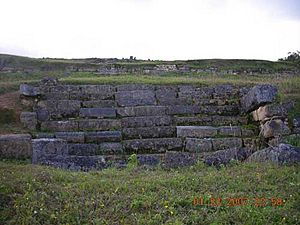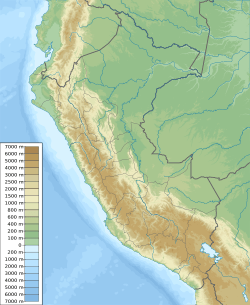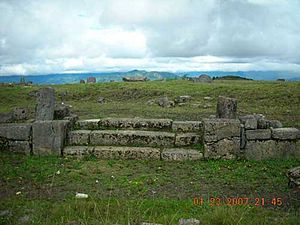Pacopampa facts for kids
|
Paqu Pampa
|
|

Remains of the archaeological site of Pacopampa
|
|
| Location | Querocoto District, Chota Province, Cajamarca Region, Peru |
|---|---|
| Coordinates | 6°20′02″S 79°0′47″W / 6.33389°S 79.01306°W |
| History | |
| Periods | Formative Period |
| Cultures | Chavín |
Pacopampa (which means "flat land" in the Quechua language) is an amazing ancient site in the northern mountains of Peru. It was once a huge ceremonial center built with carefully cut and polished stones.
People lived and used Pacopampa a very long time ago, during what archaeologists call the Formative period. This was between 1200 BC and 500 BC. Today, the land where these ancient ruins stand is owned by the National University of San Marcos. This university helps protect and study this important historical place.
Where is Pacopampa Located?
Pacopampa is found in a village also called Pacopampa. This village is high up in the mountains, about 2,140 meters (7,020 feet) above sea level! It's in the Querocoto District of the Chota Province, within the Cajamarca Region of Peru.
This site is one of the biggest ceremonial centers in the northern Peruvian highlands. Around Pacopampa, archaeologists have found about a dozen other ancient sites. Two of these, called Chapel and El Mirador, are just one kilometer to the east. Another important site from the same time, Pandanche, is about three kilometers to the southeast.
Who Explored Pacopampa?
Many people have helped us learn about Pacopampa:
- In the 1930s, a researcher named Rafael Larco Hoyle visited the area. He collected stone carvings and took them to his museum. He was the first to write about the discoveries at Pacopampa.
- Later, Pacopampa was linked to the Chavín culture. This happened when another famous archaeologist, Julio C. Tello, developed his ideas about how ancient Peruvian cultures began.
- In 1966, Pablo Macera explored the site. He wanted to protect it. In 1970, he helped the University of San Marcos buy the land so that proper excavations could begin.
- Since then, the university has continued to care for the monument.
- Hermilio Roses and Ruth Shady explored the buildings and dug up parts of the site in the 1970s. They studied the pottery found there. They realized that Pacopampa had two main periods: an earlier one (around 1200 BC) and a later one (around 700 BC) that showed influence from the Chavín culture.
The Lady of Pacopampa
In 2009, something very exciting was discovered! A team of archaeologists, led by Yuji Seki, found the tomb of a woman. They believe she was a very powerful person in the area around 900 BC.
Her tomb was shaped like a boot and was very deep. This helped keep it safe from looters for thousands of years.
Here are some facts about "The Lady of Pacopampa":
- She was about 155 centimeters (5 feet 1 inch) tall.
- When she died, she was likely between 30 and 40 years old.
- Her skull was shaped differently on purpose. This was a common practice in some ancient cultures.
- She was buried with many valuable items. These included gold earrings, ceramic pots, and necklaces made from seashells.
- Her skull was also covered in a red mineral called cinnabar.
- Archaeologists think she was buried even before the main ceremonial temple was built.
See also
 In Spanish: Pacopampa para niños
In Spanish: Pacopampa para niños




